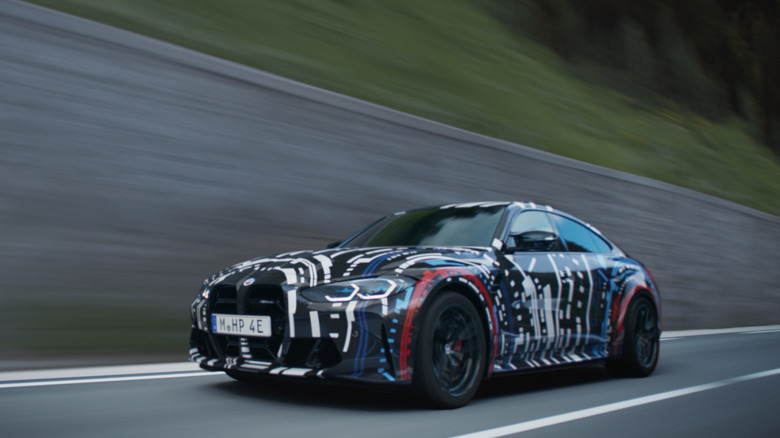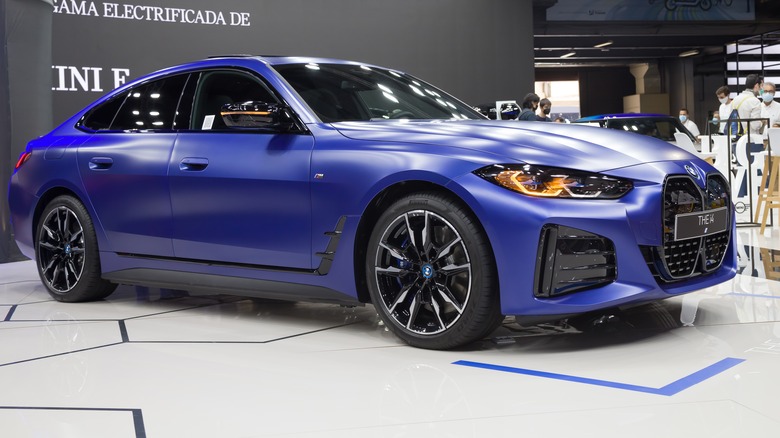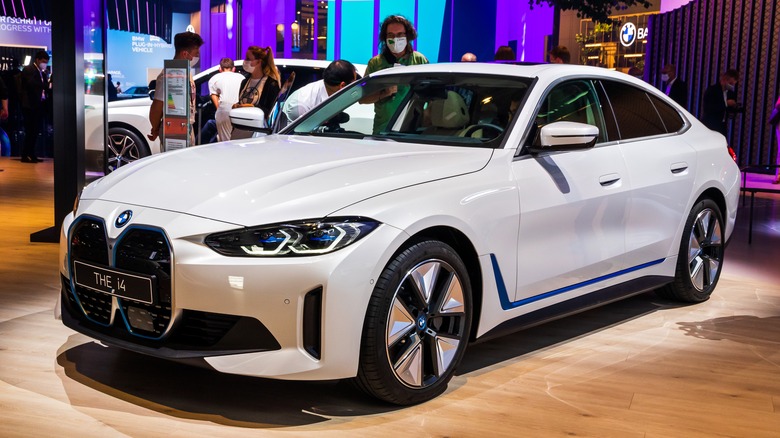BMW Is Testing Electric Cars With Four Motors For Its Fiercest M EVs
It's the BMW M Series' 50th birthday, and the German vehicle manufacturer is using the occasion as an opportunity to look toward the future. Over the past half-century, the M series has featured large, powerful, high-performance engines. The current M8 is packing a 615-horsepower V8, and probably isn't the kind of vehicle you want to show up at a Greenpeace meeting in. However, times do change and BMW is changing with those times. Earlier this year, the company built its last V-12 car, a limited edition 7-Series. It is also rapidly developing its range of electric vehicles, but going green doesn't mean compromising on performance. On the contrary, the Munich-based car maker intends on using the EV concept to take its cars — and the M series especially — to the next level.
BMW Chairman Franciscus van Meel referenced the occasion while outlining his company's electric plans. Speaking in a statement, van Meel unveiled some major news regarding BMW's production schedule, saying, "On our anniversary, we are not only looking back, but above all also looking forward. Before the end of the year, production of the BMW XM, our first high-performance car featuring a V8 M hybrid drive, will commence."
This year has already seen the launch of several all-electric BMW performance cars, including the BMW i4 M50, BMW iX M60, and BMW i7 M70 — along with a fully electric version of the flagship 7-series. But based on a recent announcement from the automaker, the all-electric M-series of the very near future could come with a unique four-wheel drive system that allows it to pull ahead of the competition.
A future all-electric M-series might consist of four-motored masterpieces
The company's M xDrive four-wheel drive system is currently in the testing phase, but has already produced some very promising results. The system gives each wheel its own electric motor and runs through a "highly integrated control unit" that takes action based on the driving conditions and the driver's choices. Along with the driving surface, several other factors are taken into consideration, including accelerator pedal position, steering angle, longitudinal and lateral acceleration, and wheel speeds. All of this is continually monitored and the optimal amount of power and torque is given to each wheel. The decisions the control unit makes are put into action within milliseconds.
BMW has already tested this technology and claims it delivered a number of benefits, including "significantly higher cornering speeds" even in tough conditions, like rain-soaked or snow-covered roads. A specific example the company gave involved the control unit eliminating understeer by temporarily giving more power to the rear outside wheel. The motors also recoup energy when braking. This has been a common feature on many EVs and hybrids for several years, but BMW's experimental drive train may be the first to optimize energy recovery on all four wheels.
The concept is being tested out on a modified BMW i4 M50 with the front end based around an adapted body strut concept taken from an M3/M4 chassis, and a radiator unit configuration modeled on current high-performance sports cars. The test car is designed to have high torsional rigidity during dynamic driving situations.
This may put BMW ahead of the competition
Usually, standard electric cars have one motor while higher-end models and those offering four-wheel drive go for two. Even ultra-high-end vehicles like the Lucid Air opt for one motor at the front and another at the back. So why go with four when a pair is enough for some of the world's most cutting-edge electric cars?
According to BMW, the reasoning is quite simple: four motors will give the vehicle access to "completely new possibilities for infinitely variable, extremely precise and at the same time very fast distribution of drive torque," according to the automaker. Because each wheel is powered by its own motor, it can be provided with the exact level of torque and power it needs in any situation. To provide an extreme example, if you have one wheel on the road and another on gravel or mud, both wheels require different levels of power and torque to perform optimally. If you apply the same amount of force to each wheel, one of two things will happen: the one on the road will either be underpowered, or the one on the rough surface will fail to get enough grip. A more common situation involves cornering. If you give the outside wheels more power, and the extra torque they need to apply that power to the road, you will get tighter and more stable cornering.
The primitive version of this system is the differential, a part that allowed a car's wheels to move at different speeds independently. Fast forward a few decades, and you have torque vectoring; it's essentially the same idea as a diff, but more advanced. Now, with its four-motor system, BMW is advancing the concept to new levels.


